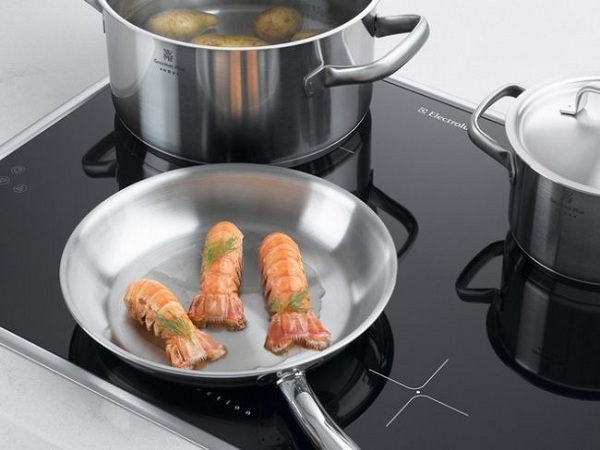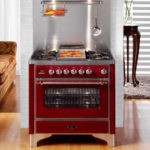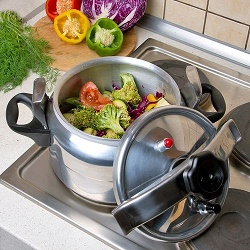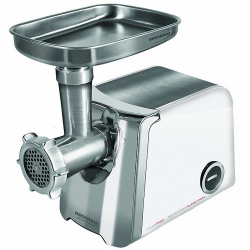What is the difference between induction and electric cookers
Every hostess wants to have in the kitchen not only functional, but also stylish modern appliances. Fortunately, now there are plenty to choose from - the range on the market is huge. Future users are at a loss: so who prepares better - electric or induction hob? Both plates will be work from the mains - that's where the similarities end. To understand the difference and make the right choice, you need to know their differences.

Content
Features of operation
Which cooktops will look better in the kitchen - electric or induction? The difference between them lies in the following nuances:
- features of the devices;
- use of suitable utensils;
- work safety;
- heating rate;
- the efficiency of the cooking process;
- ease of care.
The main difference is the principle of operation of both devices. The electric stove will first heat itself and only then the heat will transfer to the dishes located on it. Induction, embedded in the same technology, works diametrically opposite: under the working surface of the hob is a coil that activates the magnetic currents in the dish itself. This leads to only pans and pots heat up, you can not be afraid to burn yourself. There is a difference in many other factors.

- The previous difference between an induction cooker indicates using certain dishes, which has the properties of magnets. In order to save the budget, ferromagnetic stickers that “mold” on existing household utensils will also be suitable. But the electric stove is “favorable” to any kinds of pots and pans - they can be coated with both aluminum and enamel.
- Induction cooker much safer than usual - it will not turn on until dishes are installed on it. And the latter should be complete.
- Another significant competitive difference is cooking speed. Here the induction version definitely wins. The answer is again in the features of the work: the panels do not need to warm up to the right temperature for a long time, thanks to the actions of electromagnetic vortices everything happens much faster.
- Since both types of appliances are powered by the mains, the induction method of cooking turns out to be much more economical. Calculations show that in this case 1.5 times less energy is spent. Read more about stove electricity consumption. here.
- If food gets to the surface of the electric stove, it will be much more difficult to get rid of traces of cooking in case of late cleaning.
So, the induction panel will differ first of all, no matter how strange it may sound, with your mind. It will emit exactly as much heat as is needed to heat up the dishes of the desired diameter.
Why may like electric stoves
Such a variant of kitchen appliances is explained not only by habit. And, while everyone around them is striving to move to a new stage in the evolution of hobs, the standard electric stove still has quite a few adherents. And all thanks to significant advantages.
- You can connect the device without the help of a wizard, independently.
- Most modern models of electric stoves have power saving mode.
- Electrical options are relatively safe to use (the main thing is to take care of good wiring).
- When using this technique will not produce products of combustion, which will provide clean air in the kitchen.

Disadvantages of induction technology
What are the drawbacks in the work of such a technique? With electrical everything is clear: here and a long time warming up, its uneven, the danger of burn. And this is not to mention the accounts for the consumed resources. Against their background, the induction competitor bypasses all these pitfalls so well that it seems just perfect. But there are some drawbacks here too.
- Research confirms its harmful impact on other household appliances. This becomes especially noticeable if it stands nearby.
- There is also a negative myth. effects on the human body. However, such assumptions have not yet been confirmed.
- The cost of modern equipment is several times higher than that of the usual version. But for those who want to keep pace with the trends of progress, such a trifle does not matter.
- If the model has a common frequency generator operating on several burners, it is possible power loss at their simultaneous inclusion.
- Often, when working with such equipment, there is a load on the wires, and if the wiring is also old, then its use is dangerous.
What materials are used in the manufacture of technology
Choosing what is better from both proposals will look in the kitchen, we must look at the appearance of the equipment. This rule is relevant not only in terms of design and compliance with the interior, but also in terms of the practicality of the equipment used. For the manufacture of electric cookers usually use enamel coating (or stainless steel). And again, the difference between an induction panel and a conventional electrical panel is the ability to be made in a completely different material - glass ceramics.

Appearance already shows the user all the beauty and innovation of such an invention. In essence, this is a panel with burners painted on it. The heating elements are hidden inside her, but the included burner is always highlighted, which makes working with it more cautious. This choice of coverage has an understandable logical explanation.
- Aesthetic component. Yes, this panel turns out to be much more beautiful than a conventional hot plate. The stylish surface will successfully fit into any interior.
- Strength. According to the manufacturers, glass ceramics can withstand the fall of a two-kilogram load (for example, pots) from a height of 15 cm. This is indicated by European production standards. Of course, targeted hammer strikes will surely crack.
- The control of the panel can be both mechanical and touch. In the second case, it is more convenient to clean it.
The last point obliges to reveal the main secret in operation of induction equipment - there is a taboo on the use of abrasives. Immediately remove the scattered cereals and sugar (the latter can stick). Otherwise, the integrity of the upper layer may be compromised, which leads to malfunctioning of the equipment.

In thinking about what exactly should be in the kitchen - induction or electric hob, you should be guided, first of all, by your own financial capabilities - the purchase of a more modern model will be an expensive pleasure. With a positive solution to this issue, preference is given, of course, to induction appliances, which, if properly positioned in the kitchen space, will allow you to cook food faster and also save energy.
Today the market for induction hobs is replete with various options. In this diversity, it is difficult for the consumer to choose a particular option, so people often have to resort to Internet resources to find a model with the best reviews. Among the well-known models with a high rating from consumers, the Hotpoint technique is leading. The company just recently introduced a new line of induction hobs, focusing on safe use: the possibility of injury from accidental contact with a working stove at the highest heating level was minimized, since the surface of the panel is equipped with a safe control interlock system. This function heats the cooking zone exclusively under the area of the dishes, which is very important for families with small children. The important characteristics also include 4 individual cooking zones,each of which is able to reach the maximum heating level in seconds and maintain it for 4 minutes, thanks to the Booster function and the regulation of 9 heat levels using the touch controls of each slider.
In addition, this model will be interesting, both for professionals in the kitchen, and for beginners. Modern equipment of the hob provides excellent results regardless of the complexity of the recipe using 4 automatic features:
- melting mode (ideal temperature for making sauces without the risk of burning at the bottom of the dish);
- mode of extinguishing (delicate mode of cooking without boiling);
- mode of preserving heat (maintaining the temperature of the dish until it is served on the table);
- the mode of rapid boiling (for rapid boiling water).
The development of such models once again confirms that today, induction panels are more in demand and more practical to use than the outgoing electric cookers.

/rating_on.png)
/rating_off.png)












